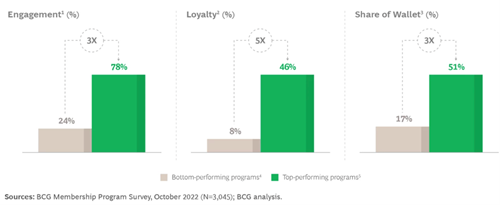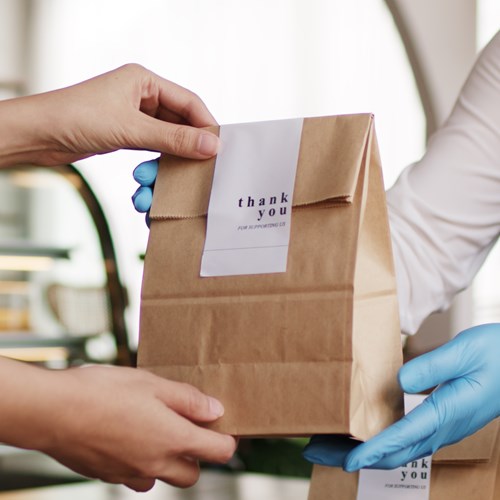The Importance of Loyalty Programs in QSR
Loyalty marketing programs for brands have proven, undeniable value for engaging, motivating, and helping retain valuable customers. Direct access to a brand’s best customers enables a significantly deeper level of insights on customer product preferences, cross-selling opportunities, and promotional uptake.
USIM has assisted clients in developing segmentation of customers based on their purchasing behaviors and equally importantly in testing and enacting marketing and messaging strategies against those segments to increase customer revenue and retention.
BACKGROUND
Study after study continues to support the significant impact loyalty programs have on sales. Loyalty members represent the highest spenders and the most frequent visitors within most categories. A critical element as 25-40% of a business’ revenue comes from repeat customers who spend 67% more per purchase than new customer (SumAll study).
In fact, loyalty programs can contribute to an increase in revenue with 57% of consumers spending more on brands to which they are loyal and a 5% increase in retention correlates with a 25% increase in revenue. (Queue-it) These profits significantly outweigh any cost and operational complexities of starting a loyalty program.
In this whitepaper we will explore the:
- Economic Benefits of loyalty programs, particularly in combating the challenges of economic instability.
- Increased Customer Retention loyalty programs create in an industry where competition is fierce, and choices abound.
- Strategies for Implementation to better leverage loyalty programs effectively.
The insights to follow are fueled by the unparalleled knowledge and expertise USIM has with loyalty programs, built on years of experience within QSR and retail, that has made us the go-to partner for brands seeking greater success with their rewards efforts. Click on the ‘Learn More’ link at any time to connect with USIM to see how we can help in your efforts.
An Effective Loyalty Program is an Essential Tool for QSR Brands
The use of customer loyalty programs has emerged as an important tactic to ‘speak’ to the rapid change in preference and behavior allowing QSR brands to better attract and retain consumers over longer periods of time. In fact, most U.S. adults (68%) want brands to “send them personalized offers and discounts based on their purchase history, rising to 74% among those who are willing to share their personal data in exchange for something of value.” (YouGov, 2021)
BCG study of effective loyalty programs reflects USIM’s experience with our QSR client base – top performing programs have a higher level of engagement and loyalty leading to increased sales.

USIM analysis of client loyalty programs uncovered key insights into effectiveness beyond the basic reward mechanisms that customers value.
REFLECTS THE EVOLVING EXPECTATIONS OF BRANDS
Consumers today are looking for a brand to go beyond a consumer’s needs, to also reflecting their values and ethics. Loyalty programs are a powerful tool to address these new consideration metrics delivering a point of ‘conversation’ where consumers are more receptive to messaging. For instance, the "My McDonald's" program rewards customers not only for purchases, but also for making eco-friendly choices such as their ‘reusable’ cups. Aligning with their customers’ desired values has translated into increased loyalty and sales.
DELIVERS MESSAGING WHERE CONSUMERS WANT
With the continued proliferation of media channels to increasingly target more finite target segments and their preferences, effective loyalty programs cut through the fragmented landscape offering a direct channel to engage customers with personalized offers and incentives. Loyalty programs offer a means of being where their customer prefers to interact with messaging. In doing so, brands can increase their organic growth and reduce customer acquisition costs. For example, Domino's "Piece of the Pie Rewards" program offset their paid media channels with email and SMS marketing which was both more efficient and effective in delivering personalized offers to customers based on their ordering history and preferences.
OPTIMIZES THE CHANGING ROLE OF WORD-OF-MOUTH (WOM)
The importance for WOM has not changed, but the way it is conveyed has evolved. Loyalty programs both encourage and provide a means for customers to share the ‘Perks’ with friends, families, or coworkers. And considering 20-50% (Branderati) of all purchasing decisions come from word-of-mouth recommendations, and 92% of shoppers trust a recommendation (Nimbly Technologies), this can be a powerful catalyst for an improving bottom line.
Additional core tactics necessary to implement effective loyalty programs include allocating the necessary resources, clearly defining the KPIs that will measure success, aligning the program with the brand’s values and marketing, implementation and education at the store level, and a user-friendly app.
Customer Data Available Through Loyalty Programs Delivers Multiple Opportunities to Increase Revenue and Traffic from New and Existing Customers
USIM have assisted QSR clients in creating multi-dimensional customer segments that reflect purchasing habits, frequency, and spending. These segments go beyond identification of top spending loyalist customers to create segments of near-loyalists, potential switchers who might be lost to the brand without immediate action.
Much deeper insights into the success of new products and promotion uptake can be taken from the customer purchase records of these custom segments. Ensuring that promotional offers and discounts work to drive incremental traffic and revenue rather than only discounting sales for the client’s best customers is critical.
USIM builds ‘lookalike’ media targeting audiences using proprietary identity graph to find prospective customers living in geographically defined trading zones around client locations who most resemble our client’s best customers.
Measuring the Success of QSR Loyalty Programs
There are several key metrics and indicators that QSR brands commonly use to gauge the effectiveness of their loyalty programs include both program-related and media-related metrics. It is critical to track success with multiple metrics to deliver an effective program.
- IMPACT ON RETENTION RATES
- NUMBER OF NEW MEMBERS/SIGN UPS
- NUMBER OF APP DOWNLOADS
- AVERAGE TRANSACTION VALUE (BASKET SIZE)
- FREQUENCY OF VISITS
- CUSTOMER FEEDBACK
Awareness of Regulatory Requirements is Critical
Maintaining strict adherence to all regulatory requirements is essential to maintain customer trust and participation as well as legal requirements.
DATA PROTECTION
Compliance with data protection regulations, such as GDPR or CCPA, is crucial when collecting and using customer data. Ensure that your loyalty program's data handling practices align with relevant regulations to protect customer privacy and avoid legal issues.
CONSUMER PRIVACY
Transparency in data collection and usage is a top concern among consumers. Be aware of how customer data is collected, stored, and shared. Provide clear privacy policies and opt-in/opt-out mechanisms to respect consumer privacy preferences.
ADA ACCESSIBILITY STANDARDS
ADA accessibility standards are essential for ensuring that all customers, including those with disabilities, can access and benefit from your loyalty program (mobile app or online platform).
The Future of Loyalty Marketing Programs
QSR loyalty programs will see an evolution in the years ahead addressing technological improvements and changing marketing strategies. These may include:
IMPACT OF AI AND MACHINE LEARNING
Personalization and Predictive Analytics
AI and machine learning technologies are in the process of revolutionizing how QSR loyalty programs engage customers. These technologies can analyze vast amounts of customer data quickly to provide hyper-personalized offers and recommendations. Predictive analytics will enable brands to anticipate customer preferences and needs, optimizing the customer experience.
Virtual Assistants
AI-driven chatbots and virtual assistants will play a significant role in loyalty program management, assisting customers with program-related inquiries, providing real-time support, and facilitating enrollment or reward redemption seamlessly through chat or voice interactions.
NEED FOR SUSTAINABILITY IN PROGRAMS
Eco-Friendly Rewards
Sustainability is a critical consideration in loyalty programs. QSR brands are introducing eco-friendly rewards, such as discounts for using reusable containers or eco-conscious packaging. Sustainable practices align with growing environmental concerns, as well as also attracting environmentally conscious consumers who prioritize responsible consumption.
Social Responsibility
Sustainability extends beyond environmental efforts. Brands can integrate social responsibility into loyalty programs, such as contributing to charitable causes with purchase. This fosters goodwill and appeals to consumers who value brands with a strong sense of social responsibility.
VOICE CAPABLE PROGRAMS
Voice-Activated Engagement
Using smart speakers and virtual assistants, QSR loyalty programs can incorporate voice-activated features to have customers enroll in programs, check rewards, or place orders. This is streamlining the customer experience and appealing to tech-savvy consumers seeking convenience.
Voice-Enabled Loyalty Assistants
Allows customers to interact with a loyalty program using natural language to provide program information, update account details, and assist with redemption enhancing customer engagement and satisfaction.
POPULATION SHIFTS (DEMOGRAPHIC, GEOGRAPHIC)
Demographic Changes
Shifts, such as changes in age and cultural preferences, have a profound impact on loyalty program design. Adapting to these evolving needs and preferences of diverse customer segments is critical. For example, younger generations may prioritize digital engagement, while older demographics may value traditional loyalty perks.
Geographic Considerations
Shifts, including changes in population density and regional preferences, influence program messaging and offerings. Tailoring loyalty programs to cater to specific geographic regions or urban vs. suburban markets, ensures relevance and resonance with local customers.
Summary
It is critical that QSR brands establish and modern and relevant loyalty scheme, supported by a robust data infrastructure. USIM can help your brand identify the right loyalty program, the resources needed to support the program, and the process to deploy, integrate, and continuously monitor / update the program.
To help your brand to implement an effective program, we have developed a (modifiable) playbook informed by our success in working with QSR partners’ programs (and other clients outside of QSR), in driving greater awareness, retention, and sales. We will assist your brand in assessing the factors that will shape your program (e.g., positioning, long-term goals), identify the customers we are targeting (e.g., existing, switcher), using the program to support your POD, designing a program that is flexible to adapt to changing behaviors over time, and identifying the benefits that deliver the best value and the lowest cost.
USIMs identity graph helps to gain insights on your customers and then find prospective customers who are most likely to be valuable new ones.
Bottom line, 84% of customers are more likely to remain brand loyal if that brand offers a loyalty program. (Queue-it) 75% of customers would switch brands if that brand had a better loyalty program. (Task Software). QSR brands (and USIM’s clients reflect this) who have a robust loyalty program are today deriving 50%+ of their sales revenue from their loyalty scheme customers and that share is set to grow.
If you are looking to introduce a loyalty program or have one in place that you would like to optimize, we would love to discuss. Click here for further information or to connect.
